Related Research Articles
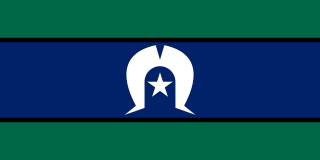
The Torres Strait Islands are an archipelago of at least 274 small islands in the Torres Strait, a waterway separating far northern continental Australia's Cape York Peninsula and the island of New Guinea. They span an area of 48,000 km2 (19,000 sq mi), but their total land area is 566 km2 (219 sq mi).
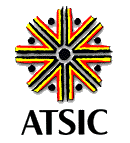
The Aboriginal and Torres Strait Islander Commission (ATSIC) (1990–2005) was the Australian Government body through which Aboriginal Australians and Torres Strait Islanders were formally involved in the processes of government affecting their lives, established under the Hawke government in 1990. A number of Indigenous programs and organisations fell under the overall umbrella of ATSIC.
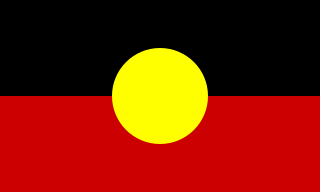
The Australian Aboriginal Flag is the official flag of Aboriginal Australians. It was granted official status in 1995 under the Flags Act 1953, together with the Torres Strait Islander Flag, in recognition of their status as Indigenous peoples of Australia. The two flags are often flown together with the Australian National Flag.

The National Library of Australia (NLA), formerly the Commonwealth National Library and Commonwealth Parliament Library, is the largest reference library in Australia, responsible under the terms of the National Library Act 1960 for "maintaining and developing a national collection of library material, including a comprehensive collection of library material relating to Australia and the Australian people", thus functioning as a national library. It is located in Parkes, Canberra, ACT.

Central Queensland is an imprecisely-defined geographical division of Queensland that centres on the eastern coast, around the Tropic of Capricorn. Its major regional centre is Rockhampton. The region extends from the Capricorn Coast west to the Central Highlands at Emerald, north to the Mackay Regional Council southern boundary, and south to Gladstone. The region is also known as Capricornia. It is one of Australia's main coal exporting regions.
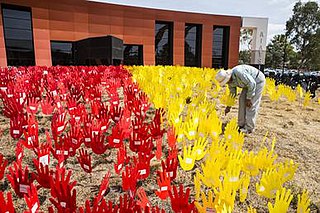
The Australian Institute of Aboriginal and Torres Strait Islander Studies (AIATSIS), established as the Australian Institute of Aboriginal Studies (AIAS) in 1964, is an independent Australian Government statutory authority. It is a collecting, publishing and research institute and is considered to be Australia's premier resource for information about the cultures and societies of Aboriginal and Torres Strait Islander peoples. The institute is a leader in ethical research and the handling of culturally sensitive material and holds in its collections many unique and irreplaceable items of cultural, historical and spiritual significance. The collection at AIATSIS has been built through over 50 years of research and engagement with Aboriginal and Torres Strait Islander communities and is now a source of language and culture revitalisation, native title research and family and community history. AIATSIS is located on Acton Peninsula in Canberra, Australian Capital Territory.

Badu or Badu Island, is an island in the Torres Strait 60 kilometres (37 mi) north of Thursday Island, Queensland, Australia. Badu Island is also a locality in the Torres Strait Island Region, and Wakaid is the only town, located on the south-east coast. This island is one of the Torres Strait Islands. The language of Badu is Kala Lagaw Ya.

Coconut Island, Poruma Island, or Puruma in the local language, is an island in the Great North East Channel near Cumberland Passage, Torres Strait, Queensland, Australia. One of the Torres Strait Islands, Coconut Island is 130 kilometres (81 mi) northeast of Thursday Island. Administratively, Coconut Island is a town and Poruma Island is the locality within the Shire of Torres.
The NAISDA Dance College is a performing arts training college based in Kariong, New South Wales for Aboriginal and Torres Strait Islander people in Australia. It was established as the Aboriginal Islander Skills Development Scheme (AISDS) in 1975, which became the National Aboriginal and Islander Skills Development Association (NAISDA) in 1988. The date of establishment of the college is usually cited as 1976, although some sources report it as 1975.

The National Film and Sound Archive of Australia (NFSA), known as ScreenSound Australia from 1999 to 2004, is Australia's audiovisual archive, responsible for developing, preserving, maintaining, promoting and providing access to a national collection of film, television, sound, radio, video games, new media, and related documents and artefacts. The collection ranges from works created in the late nineteenth century when the recorded sound and film industries were in their infancy, to those made in the present day.
Indigenous Australian customary law refers to the legal systems and practices uniquely belonging to Indigenous Australians of Australia, that is, Aboriginal and Torres Strait Islander people.
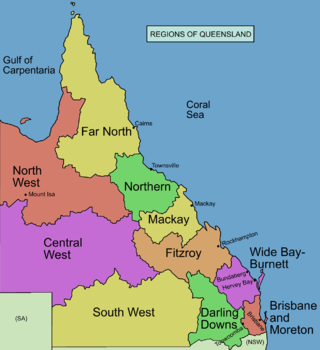
The Gulf Country or North West Queensland is the region of woodland and savanna grassland surrounding the Gulf of Carpentaria in north western Queensland and eastern Northern Territory on the north coast of Australia. The region is also called the Gulf Savannah. The Gulf Country is crossed by the Savannah Way highway.

Trove is an Australian online library database owned by the National Library of Australia in which it holds partnerships with source providers National and State Libraries Australia, an aggregator and service which includes full text documents, digital images, bibliographic and holdings data of items which are not available digitally, and a free faceted-search engine as a discovery tool.
Aboriginal Islander Dance Theatre (AIDT) was the first dance company used to train Aboriginal and Torres Strait Islander students on their dancing career, and grew into a performance group. Originating in the National Aboriginal and Islander Skills Development Association, it was based in Sydney, New South Wales, and operated from 1976 to 1998.
Tjayanka Woods is an Australian Aboriginal artist. She was one of the pioneers of the art movement across the Ngaanyatjarra, Pitjantjatjara and Yankunytjatjara lands, which began in 2000. She is best known for her paintings, but also a craftswoman who makes baskets and other woven artworks. Her paintings are held in the Art Gallery of Western Australia, National Gallery of Victoria, and the National Gallery of Australia.
The Australian Web Archive (AWA) is an publicly available online database of archived Australian websites, hosted by the National Library of Australia (NLA) on its Trove platform, an online library database aggregator. It comprises the NLA's own PANDORA archive, the Australian Government Web Archive (AGWA) and the National Library of Australia's ".au" domain collections. Access is through a single interface in Trove, which is publicly available. The Australian Web Archive was created in March 2019, and is one of the biggest web archives in the world. Its purpose is to provide a resource for historians and researchers, now and into the future.
National edeposit (NED) is a collaboration between Australia's nine national, state and territory libraries which provides for the legal deposit, management, storage and preservation of, and access to, published electronic material across Australia. It is a website, a system and a service, the result of a project by National and State Libraries Australia, and is a world-first collaboration. The National Library of Australia (NLA), Libraries ACT, Libraries Tasmania, Northern Territory Library, State Library of New South Wales, State Library of Queensland, State Library of South Australia, State Library Victoria and the State Library of Western Australia are the member organisations, while the system is hosted and managed by the NLA.
David Robert Horton is an Australian writer who has been described as a polymath, with qualifications and careers in science and the arts. He is known for his compilation of the work The Encyclopaedia of Aboriginal Australia: Aboriginal and Torres Strait Islander history, society and culture in 1994, and its accompanying map of Aboriginal groupings across Australia.
Dawn was an Australian magazine created by the New South Wales Aborigines Welfare Board and aimed at Aboriginal Australians. It ran monthly from January 1952 until December 1968. Two issues were published in 1969, before the disbanding of the Aboriginal Welfare Board led to the publication ceasing.
References
- ↑ "History and Achievements". PANDORA. 18 February 2009.
- ↑ "About Pandora". Pandora Archive. 5 June 2018. Retrieved 1 May 2020.
- ↑ Hegarty, Kieran (25 July 2022). "The invention of the archived web: tracing the influence of library frameworks on web archiving infrastructure". Internet Histories. 6 (4): 432–451. doi:10.1080/24701475.2022.2103988. ISSN 2470-1475. S2CID 251081177.
- 1 2 3 "NLA Selection Guidelines". Pandora Archive. 5 June 2018. Retrieved 30 April 2020.
- 1 2 Whiting, Julie (August 2000). "New look marks milestone for PANDORA Tour de Force". National Library of Australia: Gateways. National Library of Australia. Archived from the original on 23 May 2004. Retrieved 17 March 2014.
- ↑ Webb, Colin (December 2000). "Because It Belongs to All of Us: National Arrangements for Digital Preservation in Australian Libraries, Australian Academic & Research Libraries". Australian Academic and Research Libraries. 31 (4): 154–172. doi: 10.1080/00048623.2000.10755132 . ISSN 1839-471X.
Published online: 28 Oct 2013 [Routledge]
- ↑ "Pandora Archive". Australian Institute of Aboriginal and Torres Strait Islander Studies. Retrieved 30 April 2020.
- ↑ "Other archives". Pandora Archive. 24 August 2011. Retrieved 30 April 2020.
- 1 2 "NLA Selection Guidelines". Pandora Archive. 5 June 2018. Retrieved 1 May 2020.
- ↑ "WHAT IS LEGAL DEPOSIT?". National Library of Australia. Retrieved 2 February 2014.
- ↑ "Notice to Publisher of Online Material". National Library of Australia. Retrieved 2 February 2014.
- ↑ "Digital Archiving System". Pandora Archive. 27 June 2007. Retrieved 1 May 2020.
- ↑ "Preserving and Accessing Networked DOcumentary Resources of Australia". Pandora Archive. Retrieved 30 April 2020.
- ↑ "Australian web archive". Trove. Retrieved 30 April 2020.
- ↑ "Archived websites". National Library of Australia. 23 March 2020. Retrieved 30 April 2020.
- ↑ Koerbin, Paul (11 February 2015). "The Australian Government Web Archive". National Library of Australia. Retrieved 30 April 2020.
- ↑ "Statistics". Pandora Archive. 26 February 2020. Retrieved 30 April 2020.